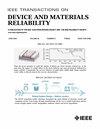总电离剂量效应对SONOS FLASH的降解行为及机理研究
IF 2.3
3区 工程技术
Q2 ENGINEERING, ELECTRICAL & ELECTRONIC
IEEE Transactions on Device and Materials Reliability
Pub Date : 2024-12-30
DOI:10.1109/TDMR.2024.3524100
引用次数: 0
摘要
本文基于180nm嵌入式FLASH工艺,设计和制作了2T SONOS FLASH,其中包括一个MOSFET和一个SONOS FLASH晶体管。采用带间隧道诱导热电子和Fowler-Nordheim对FLASH晶体管进行编程和擦除,实现不同层次的擦除,并利用中隙技术研究了辐射引起的电退化机理。为了从物理层面上阐明降解机理,从原子和电子的角度进行了第一性原理计算。电场和外界环境对电荷损失起着至关重要的作用。较高的电场会加剧氧化电荷的形成,在富氧环境下可以达到抗辐射硬度。外加电场可以有效地改变$\alpha $ -SiO2的氧空位和氢的电子性质。本研究从实验和理论模拟两方面为SONOS FLASH单元在不同程度上的电退化提供了新的视角,可为先进空间计算芯片的设计提供帮助。本文章由计算机程序翻译,如有差异,请以英文原文为准。
Degradation Behavior and Mechanism of SONOS FLASH by Total Ionization Dose Effects
In this paper, the 2T SONOS FLASH is designed and fabricated based on 180 nm embedded FLASH process which includes one MOSFET and one SONOS FLASH transistor. The FLASH transistors are programmed and erased by band-to-band tunneling-induced hot electron and Fowler-Nordheim to realize different levels, and the mechanisms of the electrical degradation caused by radiation are investigated by the mid-gap technique. In order to clarify the degradation mechanism from the physical level, the first principle calculations are performed from the atomic and electronic term. The electric fields and the external environment are proved to play a crucial role in the charge loss. The higher electric fields can exacerbate the formation of the oxide charge, and the anti-radiation hardness can be achieved with oxygen-rich environment. The external field can efficiently change the electronic properties of $\alpha $ -SiO2 with oxygen vacancy and hydrogen. This study provides a novel perspective of electrical degradations on the SONOS FLASH unit in different levels from both the experiments and theoretical simulations, which can be helpful for the design of advanced computational chips in space.
求助全文
通过发布文献求助,成功后即可免费获取论文全文。
去求助
来源期刊

IEEE Transactions on Device and Materials Reliability
工程技术-工程:电子与电气
CiteScore
4.80
自引率
5.00%
发文量
71
审稿时长
6-12 weeks
期刊介绍:
The scope of the publication includes, but is not limited to Reliability of: Devices, Materials, Processes, Interfaces, Integrated Microsystems (including MEMS & Sensors), Transistors, Technology (CMOS, BiCMOS, etc.), Integrated Circuits (IC, SSI, MSI, LSI, ULSI, ELSI, etc.), Thin Film Transistor Applications. The measurement and understanding of the reliability of such entities at each phase, from the concept stage through research and development and into manufacturing scale-up, provides the overall database on the reliability of the devices, materials, processes, package and other necessities for the successful introduction of a product to market. This reliability database is the foundation for a quality product, which meets customer expectation. A product so developed has high reliability. High quality will be achieved because product weaknesses will have been found (root cause analysis) and designed out of the final product. This process of ever increasing reliability and quality will result in a superior product. In the end, reliability and quality are not one thing; but in a sense everything, which can be or has to be done to guarantee that the product successfully performs in the field under customer conditions. Our goal is to capture these advances. An additional objective is to focus cross fertilized communication in the state of the art of reliability of electronic materials and devices and provide fundamental understanding of basic phenomena that affect reliability. In addition, the publication is a forum for interdisciplinary studies on reliability. An overall goal is to provide leading edge/state of the art information, which is critically relevant to the creation of reliable products.
 求助内容:
求助内容: 应助结果提醒方式:
应助结果提醒方式:


